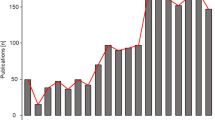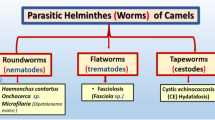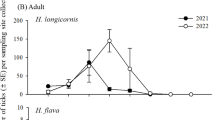Abstract
Culicoides biting midges are small dipterous insects (Diptera: Ceratopogonidae) which are known to be vectors of arboviruses, bacteria, protozoan and helminth parasites that can cause disease and mortality in livestock and poultry globally. Detailed knowledge of the Culicoides species composition and biology is essential to assess the risk of the introduction and transmission of pathogens. The aim of this study was to obtain data on Culicoides species composition and flying activity in southeastern Lithuania and to determine the meteorological variables related to the abundance of Culicoides biting midges. Biting midges were collected in Verkiai Regional Park, southeastern Lithuania, using an Onderstepoort trap once a week from April to October 2016 and 2018, and from April to July 2019; 7332 Culicoides females belonging to 22 species were identified. Both morphology and DNA barcoding were used for identification. The number of specimens trapped was highest for the Obsoletus Group, followed by Culicoides kibunensis and Culicoides impunctatus. The highest relative abundance and diversity of biting midges were found in May and June. The number of trapped biting midges correlated positively with the mean air temperature. The first biting midges in spring were caught when the mean daily temperature rose higher than 10 °C. No Culicoides were detected when the air temperature dropped below 5 °C in autumn. Wind speed and air humidity had no statistically significant effect on Culicoides abundance.


Similar content being viewed by others
References
Ander M, Troell K, Chirico J (2013) Barcoding of biting midges in the genus Culicoides: a tool for species determination. Med Vet Entomol 27:323–331. https://doi.org/10.1186/s13071-020-04114-1
Ayllón T, Nijhof AM, Weiher W, Bauer B, Allène X, Clausen PH (2014) Feeding behaviour of Culicoides spp. (Diptera: Ceratopogonidae) on cattle and sheep in northeast Germany. Parasit Vectors 7:34. https://doi.org/10.1186/1756-3305-7-34
Bernotienė R (2002) New data on the fauna of biting midges (Diptera, Ceratopogonidae) from Lithuania. Acta Zool Litu 12:288–293. https://doi.org/10.1080/13921657.2002.10512516
Bernotienė R, Bartkevičienė G (2011) Relationship between the development of Simulium maculatum (Diptera: Simuliidae) and the thermal regime. Eur J Entomol 108:397–402. https://doi.org/10.14411/eje.2011.050
Bernotienė R, Žiegytė R, Vaitkutė G, Valkiūnas G (2019) Identification of a new vector species of avian haemoproteids, with a description of methodology for the determination of natural vectors of haemosporidian parasites. Parasit Vectors 12:307. https://doi.org/10.1186/s13071-019-3559-8
Boorman J (1997) Family Ceratopogonidae. In: Papp L, Darvas B (eds) Manual of Palaearctic Diptera. Science Herald, Budapest, pp 349–368
Borkent A, Dominiak P (2020) Catalog of the biting midges of the world (Diptera: Ceratopogonidae). Zootaxa 4787:1–377. https://doi.org/10.11646/zootaxa.4787.1.1
Carpenter S, Wilson A, Mellor PS (2009) Culicoides and the emergence of bluetongue virus in northern Europe. Trends Microbiol 17:172–178. https://doi.org/10.1016/j.tim.2009.01.001
Carpenter S, Groschup MH, Garros C, Felippe-Bauer ML, Purse B (2013) Culicoides biting midges, arboviruses and public health in Europe. Antivir Res 100:102–113. https://doi.org/10.1016/j.antiviral.2013.07.020
Collins AB, Mee JF, Doherty ML, Barrett DJ, England ME (2018) Culicoides species composition and abundance on Irish cattle farms: implications for arboviral disease transmission. Parasit Vectors 11:472. https://doi.org/10.1186/s13071-018-3010-6
Elbers ARW, Meiswinkel R, van Weezep E, Sloet van Oldruitenborgh-Oosterbaan MM, Kooi EA (2013) Schmallenberg virus detected by RT-PCR in Culicoides biting midges captured during the 2011 epidemic in the Netherlands. Emerg Infect Dis 19:106–109. https://doi.org/10.3201/eid1901.121054
Folmer O, Black M, Hoeh W, Lutz R, Vrijenhoek R (1994) DNA primers for amplification of mitochondrial cytochrome c oxidase subunit I from diverse metazoan invertebrates. Mol Mar Biol Biotechnol 3:294–299
Glukhova VM (1989) Blood-sucking midges of the genera Culicoides and Forcipomyia (Ceratopogonidae). In: Bychovsky BE (ed) Fauna of the USSR, vol 139. Nauka, Leningrad, pp 1–408
Gutsevich AV (1973) Dipterous insects. Bloodsucking biting midges (Ceratopogonidae). In: Bychovsky BE (ed) Fauna of the USSR, vol 3. Nauka, Leningrad, pp 1–149
Hall TA (1999) A user-friendly biological sequence alignment editor and analysis program for Windows 98/98/NT. Nucleic Acids Symp Ser 41:95–98
Kameke D, Kampen H, Walther D (2017) Activity of Culicoides spp. (Diptera: Ceratopogonidae) inside and outside of livestock stables in late winter and spring. Parasitol Res 116:881–889. https://doi.org/10.1007/s00436-016-5361-2
Kettle DS (1969) The biting habits of Culicoides furens (Poey) and C. barbosai Wirth & Blanton. I. The 24-h cycle, with a note on differences between collectors. Bull Entomol Res 59:21–31
LHS = Lithuanian Hydrometeorological Service (2013) Lithuanian Hydrometeorological Service, climate atlas of Lithuania. Lithuanian Hydrometeorological Service, Petro ofsetas, Vilnius, pp 1–175
Mathieu B, Cêtre-Sossah C, Garros C, Chavernac D, Balenghien T, Carpenter S, Setier-Rio ML, Vignes-Lebbe R, Ung V, Candolfi E, Delécolle JC (2012) Development and validation of IIKC: an interactive identification key for Culicoides (Diptera: Ceratopogonidae) females from the western Palaearctic region. Parasit Vectors 5:137. https://doi.org/10.1186/1756-3305-5-137
Mellor PS, McCraig J (1974) The probable cause of “sweet itch” in England. Vet Rec 95:411–415
Menzel A, Sparks TH, Estrella N, Koch E, Aasa A, Ahas R, Alm-Kübler K, Bissolli P, Braslavská O, Briede A, Chmielewski FM, Crepinsek Z, Curnel Y, Dahl Å, Defila C, Donnelly A, Filella Y, Jatczak K, Måge F, Mestre A, Nordli Ø, Peñuelas J, Pirinen P, Remišová V, Scheifinger H, Striz M, Susnik A, Van Vliet AJH, Wielgolaski F-E, Zach S, Zust A (2006) European phenological response to climate change matches the warming pattern. Glob Chang Biol 12:1969–1976. https://doi.org/10.1111/j.1365-2486.2006.01193.x
Mignotte A, Garros C, Gardès L, Balenghien T, Duhayon M, Rakotoarivony I, Tabourin L, Poujol L, Mathieu B, Ibañez-Justicia A, Deniz A, Cvetkovikj A, Purse BV, Ramilo DW, Stougiou D, Werner D, Pudar D, Petrić D, Veronesi E, Jacobs F, Kampen H, Pereira da Fonseca I, Lucientes J, Navarro J, de la Puente JM, Stefanovska J, Searle KR, Khallaayoune K, Culverwell CL, Larska M, Bourquia M, Goffredo M, Bisia M, England M, Robin M, Quaglia M, Miranda-Chueca MÁ, Bødker R, Estrada-Peña R, Carpenter S, Tchakarova S, Boutsini S, Sviland S, Schäfer SM, Ozoliņa Z, Segliņa Z, Vatansever Z, Huber K (2020) The tree that hides the forest: cryptic diversity and phylogenetic relationships in the Palaearctic vector Obsoletus/Scoticus Complex (Diptera: Ceratopogonidae) at the European level. Parasit Vectors 13:265. https://doi.org/10.1186/s13071-020-04114-1
Möhlmann TWR, Wennergren U, Tälle M, Favia G, Damiani C, Bracchetti L, Takken W, Koenraadt CJM (2018) Community analysis of the abundance and diversity of biting midge species (Diptera: Ceratopogonidae) in three European countries at different latitudes. Parasit Vectors 11:217. https://doi.org/10.1186/s13071-018-2792-x
Mraz R, Orszagh I (1998) Biting midges of the genus Culicoides (Diptera, Ceratopogonidae) collected by light trap on the right bank of the Danube in Bratislava (Slovakia). Biol Sect Zool 53:239–246
Nielsen O (1971) Some observations on biting midges (Diptera: Ceratopogonidae) attacking grazing cattle in Denmark. Insect Syst Evol 2:94–98
Olias P, Wegelin M, Zenker W, Freter S, Gruber AD, Klopfleisch R (2011) Avian malaria deaths in parrots, Europe. Emerg Infect Dis 17:950–952. https://doi.org/10.3201/eid1705.101618
Pages N, Munoz-Munoz F, Talavera S, Sarto V, Lorca C, Nunez JI (2009) Identification of cryptic species of Culicoides (Diptera: Ceratopogonidae) in the subgenus Culicoides and development of species-specific PCR assays based on barcode regions. Vet Parasitol 165:298–310. https://doi.org/10.1016/j.vetpar.2009.07.020
Pakalniškis S, Bernotienė R, Lutovinovas E, Petrašiūnas A, Podėnas S, Rimšaitė J, Sæther OA, Spungis V (2006) Checklist of Lithuanian Diptera. New Rare Lith Insect Spec 18:16–154
Pudar D, Petrić D, Allène X, Alten B, Ayhan N, Cvetkovikj A, Garros C, Goletić T, Gunay F, Hlavackova K, Ćupina AI, Kavran M, Lestinova T, Mathieu B, Mikov O, Pajović I, Rakotoarivony I, Stefanovska J, Vaselek S, Zuko A, Balenghien T (2018) An update of the Culicoides (Diptera: Ceratopogonidae) checklist for the Balkans. Parasit Vectors 11:462. https://doi.org/10.1186/s13071-018-3051-x
Purse BV, Nedelchev N, Georgiev G, Veleva E, Boorman J, Denison E, Veronesi E, Carpenter S, Baylis M, Mellor PS (2006) Spatial and temporal distribution of bluetongue and its Culicoides vectors in Bulgaria. Med Vet Entomol 20:335–344. https://doi.org/10.1111/j.1365-2915.2006.00636.x
Purse BV, Carpenter S, Venter GJ, Bellis G, Mullens BA (2015) Bionomics of temperate and tropical Culicoides midges: knowledge gaps and consequences for transmission of Culicoides-borne viruses. Annu Rev Entomol 60:373–392
Remm H (1955) Fauna of bloodsucking dipterans in Estonian SSR. Dissertation, University of Tartu, Estonia
Remm H (1966) On the Lithuanian biting midges (Diptera, Heleidae). Tartu Riikliku Ulikooli Toimetised 180:53–71
Richardson D, Jury FL, Blaakmeer K, Komdeur J, Burke T (2001) Parentage assignment and extra-group paternity in a cooperative breeder: the Seychelles warbler (Acrocephalus sechellensis). Mol Ecol 10:2263–2273. https://doi.org/10.1046/j.0962-1083.2001.01355.x
Ruosteenoja K, Räisänen J, Venäläinena A, Kämäräinen M (2016) Projections for the duration and degree days of the thermal growing season in Europe derived from CMIP5 model output. Int J Climatol 36:3039–3055. https://doi.org/10.1002/joc.4535
Saegerman C, Martinelle L, Dal Pozzo F, Kirschvink N (2014) Preliminary survey on the impact of Schmallenberg virus on sheep flocks in south of Belgium. Transbound Emerg Dis 61:469–472. https://doi.org/10.1111/tbed.12047
Sanders CJ, Shortall CR, Gubbins S, Burgin L, Gloster J, Harrington R, Reynolds DR, Mellor PS, Carpenter S (2011) Influence of season and meteorological parameters on flight activity of Culicoides biting midges. J Appl Ecol 48:1355–1364. https://doi.org/10.1111/j.1365-2664.2011.02051.x
Sanders CJ, Gubbins S, Mellor PS, Barber J, Golding N, Harrup LE, Carpenter ST (2012) Investigation of diel activity of Culicoides biting midges (Diptera: Ceratopogonidae) in the United Kingdom by using a vehicle-mounted trap. J Med Entomol 49:757–765. https://doi.org/10.1603/ME11259
Santiago-Alarcon D, Havelka P, Schaefer HM, Segelbacher G (2012) Bloodmeal analysis reveals avian Plasmodium infections and broad host preferences of Culicoides (Diptera: Ceratopogonidae) vectors. PLoS One 7:e31098. https://doi.org/10.1371/journal.pone.0031098
Santiago-Alarcon D, Havelka P, Pineda E, Segelbacher G, Schaefer HM (2013) Urban forests as hubs for novel zoonosis: blood meal analysis, seasonal variation in Culicoides (Diptera: Ceratopogonidae) vectors, and avian haemosporidians. Parasitology 140:1799–1810. https://doi.org/10.1017/S0031182013001285
Sarto i Monteys V, Saiz-Ardanaz M (2003) Culicoides midges in Catalonia (Spain), with special reference to likely bluetongue virus vectors. Med Vet Entomol 17:288–293. https://doi.org/10.1046/j.1365-2915.2003.00441.x
Sarvašová A, Kočišová A, Halán M, Delécolle JC, Mathieu B (2014) Morphological and molecular analysis of the genus Culicoides (Diptera: Ceratopogonidae) in Slovakia with five new records. Zootaxa 3872:541–560. https://doi.org/10.11646/zootaxa.3872.5.6
Semenza JC, Menne B (2009) Climate change and infectious diseases in Europe. Lancet Infect Dis 9:365–375. https://doi.org/10.1016/S1473-3099(09)70104-5
Svobodová M, Dolnik OV, Čepička I, Rádrová J (2017) Biting midges (Ceratopogonidae) as vectors of avian trypanosomes. Parasit Vectors 10:224. https://doi.org/10.1186/s13071-017-2158-9
Talavera S, Muñoz-Muñoz F, Mauricio DM, Marta VM, Soler-Membrives A, Oleaga A, Arenas A, Ruiz-Fons F, Estrada R, Pages N (2015) Culicoides species communities associated with wild ruminant ecosystems in Spain: tracking the way to determine potential bridge vectors for arboviruses. PLoS One 10:e0141667. https://doi.org/10.1371/journal.pone.0141667
Tsutsui T, Hayama Y, Yamakawa M, Shirafuji H, Yanase T (2011) Flight behaviour of adult Culicoides oxystoma and Culicoides maculatus under different temperatures in the laboratory. Parasitol Res 108:1575–1578. https://doi.org/10.1007/s00436-010-2048-y
Valkiūnas G (2005) Avian malaria parasites and other haemosporidia. CRC Press, Boca Raton
van der Schrier G, van den Besselaar EJM, Klein Tank AMG, Verver G (2013) Monitoring European averaged temperature based on the E-OBS gridded dataset. J Geophys Res - Atmos 118:5120–5135. https://doi.org/10.1002/jgrd.50444
Veldhuis AM, Santman-Berends IM, Gethmann JM, Mars MH, van Wuyckhuise L, Vellema P, Holsteg M, Höreth-Böntgen D, Conraths FJ, van Schaik G (2014) Schmallenberg virus epidemic: impact on milk production, reproductive performance and mortality in dairy cattle in the Netherlands and Kleve district, Germany. Prev Vet Med 116:412–422. https://doi.org/10.1016/j.prevetmed.2014.04.015
Venter GJ, Majatladi DM, Labuschagne K, Boikanyo SNB, Morey L (2012) The attraction range of the Onderstepoort 220 V light trap for Culicoides biting midges as determined under South African field conditions. Vet Parasitol 190:222–229. https://doi.org/10.1016/j.vetpar.2012.05.019
Venter GJ, Boikanyo SNB, de Beer CJ (2019) The influence of temperature and humidity on the flight activity of Culicoides imicola both under laboratory and field conditions. Parasit Vectors 12:4. https://doi.org/10.1186/s13071-018-3272-z
Žiegytė R, Markovets MY, Bernotienė R, Mukhin A, Iezhova TA, Valkiūnas G, Palinauskas V (2017) The widespread biting midge Culicoides impunctatus (Ceratopogonidae) is susceptible to infection with numerous Haemoproteus (Haemoproteidae) species. Parasit Vectors 10:397. https://doi.org/10.1186/s13071-017-2317-z
Acknowledgements
The authors thank the staff of the laboratory of Ecology and Physiology of Hydrobionts, Nature Research Centre, Vilnius, Lithuania, for assistance in Culicoides trapping. We are grateful to Dr. Adrian Pont, Dr. Ravinder Sehgal and Dr. Carolina Romeiro Fernandes Chagas for language editing.
Availability of data and material
The collection material is available at Nature Research Centre (Vilnius).
Funding
The study was supported by the open access to research infrastructure of the Nature Research Centre under the Lithuanian open access network initiative and the Research Council of Lithuania (S-MIP-17-27).
Author information
Authors and Affiliations
Corresponding author
Ethics declarations
Ethics approval
Not applicable.
Competing interests
The authors declare no competing interests.
Additional information
Section Editor: Helge Kampen
Publisher’s note
Springer Nature remains neutral with regard to jurisdictional claims in published maps and institutional affiliations.
Supplementary information
Supplementary information 1
Numbers of Culicoides females of different species collected per night each week (DOCX 39 kb)
Supplementary information 2
Maximum likelihood phylogenetic tree (Kimura 2-Parameter model) based on Culicoides obsoletus (MW205939–MW205945) and Culicoides scoticus (MW205919–MW205921) COI sequences obtained during this study and representative sequences from GenBank deposited and discussed by Mignotte et al. (2020). Culicoides festivipennnis (MW205910) was used as an outgroup (PDF 45 kb)
Supplementary information 3
Relation (single dots) between mean air temperature (°C) and number of collected Culicoides (log10 scale) as determined from May to October (2016, 2018, 2019), and its linear trend (line) (PNG 163 kb)
Rights and permissions
About this article
Cite this article
Bernotienė, R., Bartkevičienė, G. & Bukauskaitė, D. The flying activity of biting midges (Ceratopogonidae: Culicoides) in Verkiai Regional Park, southeastern Lithuania. Parasitol Res 120, 2323–2332 (2021). https://doi.org/10.1007/s00436-021-07147-2
Received:
Accepted:
Published:
Issue Date:
DOI: https://doi.org/10.1007/s00436-021-07147-2




